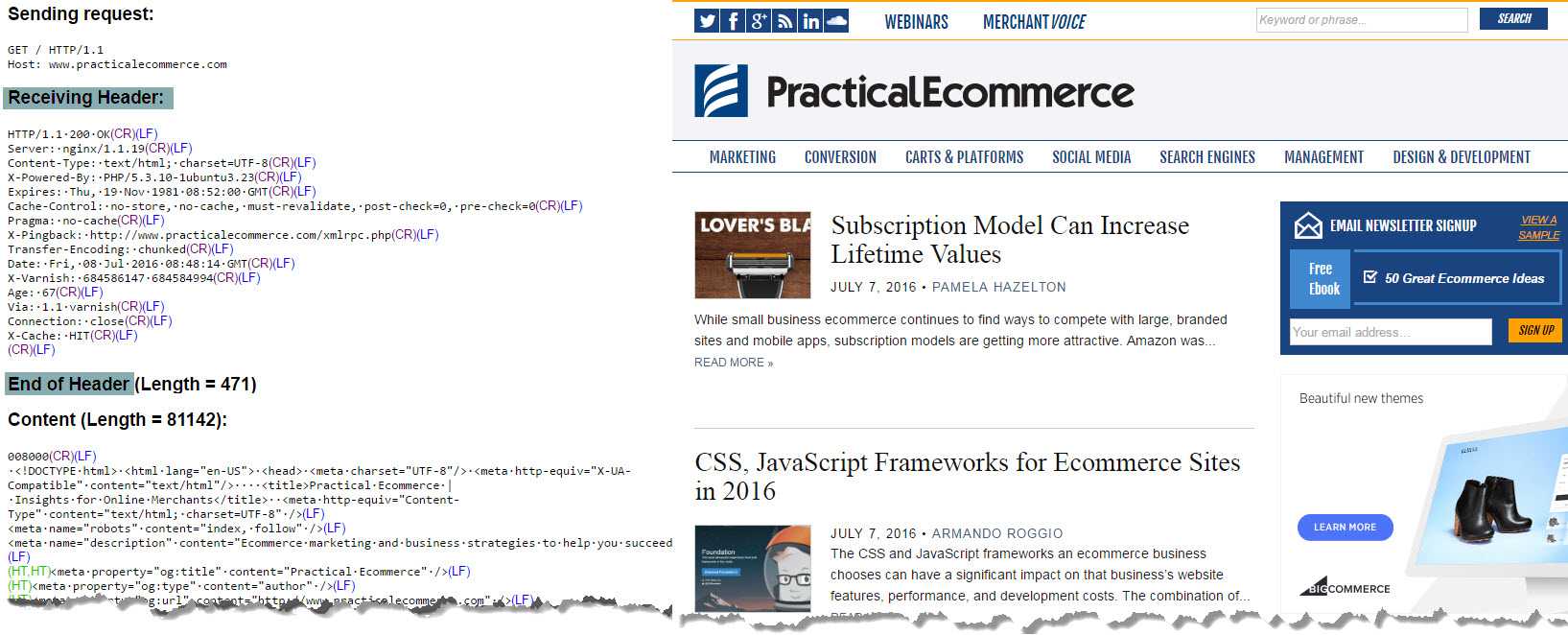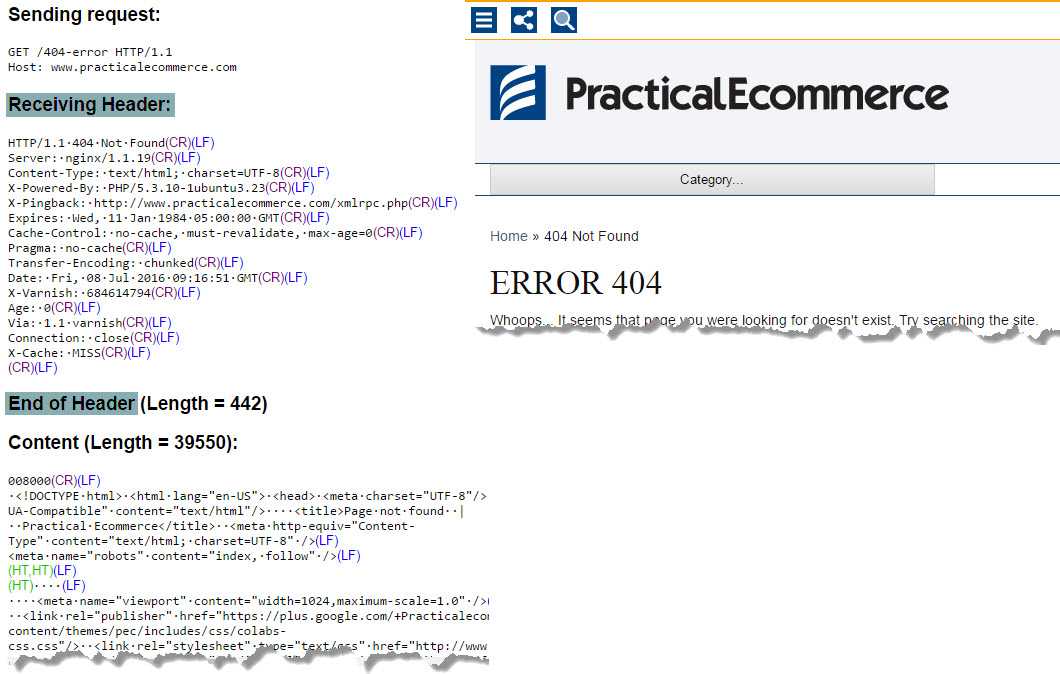Servers are the foundation of the web, but their archaic status codes have a big impact on search engine optimization that few marketers understand well enough. Three types of server header status codes actually drain away SEO value, while two are beneficial.
When your web server receives a request, it first returns a server header status code followed by additional information, such as the HTML code to display a web page to a shopper — that is, unless something goes wrong. Each different type of server header status code delivers a different message and set of code to the shopper’s browser, and has a different impact on search engine optimization.
For example, when your browser displays the home page of Practical Ecommerce, it first sends the server hosting www.practicalecommerce.com a request. Practical Ecommerce’s server replies as shown below with the server header and HTML code to display in the browser. The header is the piece that begins with the line “HTTP/1.1 200 OK.”

The server header status code and sample HTML for the home page of Practical Ecommerce.
Your developers understand these server header status codes and will use them as they discuss issues with the site that may impact SEO. It’s important that marketers know the lingo as well to help make decisions that will improve SEO performance.
Beneficial Status Codes
The most typical and beneficial server header status code is 200 OK, which results in a web page displayed in the shopper’s browser. The example image of Practical Ecommerce’s home page above shows a 200 OK server header status code in action.
Presuming the page displayed is the desired page, a 200 OK server header status code is the best possible result for SEO. It tells the search engines that things are operating as expected. Search engines, in turn, interpret this to mean over time that the page can be trusted to operate as expected if their algorithms deem the content to be beneficial to searchers.
If a 200 OK status can’t be delivered because the content no longer exists, a 301 Moved Permanently server header status code is the next best option. Commonly known as a 301 redirect, it serves as a change of address card to let search engines and browsers know where the content can be found now. For SEO, 301 redirects perform a uniquely beneficial set of services: redirecting the user to the correct content, passing link authority to the new URL, prompting deindexation of the old URL.
Presuming the page displayed is the desired page, a 200 OK server header status code is the best possible result for SEO.
A 301 redirect should always point to a URL that returns a 200 OK server header status code. For example, let’s say that a category page selling whitening toothpaste is being combined with one that sells all tooth care products. The URL for whitening toothpaste would no longer need to exist. That URL should be 301 redirected to the URL for all tooth care products, which would subsequently return a 200 OK and display the page for all tooth care products. For more on 301 redirects in general and how to wield them for redesigns and other uses, read “For Redesigns, Protect SEO with 301 Redirect Strategy.”
Harmful Status Codes
Not all server header status codes are beneficial, however.
The brother to the beneficial 301 redirect, the 302 Found server header status code, is actually harmful to SEO. Also known as 302 redirects, the 302 Found only redirects the requester to the new content. For shoppers, a simple redirect is fine. They get the content, make a purchase, and no one is the wiser. However, 302 redirects lack the SEO benefits that 301 redirects offer: 302 redirects do not pass link authority to the new page to help the new page rank more strongly, and they do not prompt the search engines to deindex the old URL. The default redirect should nearly always be a 301 redirect.
… the 302 Found server header status code, is actually harmful to SEO.
If the server believes that the requesting user is asking for something in error, such as a page that is no longer available, the server return a 400-level server header status code. The most common of these status codes are the 404 Not Found and 410 Gone. These error codes are more visible because they come with some kind of visible error message. For example, the image below shows the server header status code and hypothetical error message displayed when you type in a random string of characters on Practical Ecommrece’s site.

The server header status code and sample HTML for a hypothetical error page on Practical Ecommerce. Click image to enlarge.
From an SEO standpoint, 404s are a mixed blessing at best. They tell the search engines that the URL is dead and should be deindexed. Deindexation is good in that it means the site’s index isn’t cluttered up with a bunch of dead pages that search engines have to sift through to find the good content that should really rank for searchers.
But, on the other hand, a 404 or 410 error also wastes link authority. Unlike a 301 redirect, which passes the link authority to a new page, the 404 error just lets it wither away. And since link authority is the most precious commodity in SEO, it’s important to 301 redirect as many old URLs as possible instead of returning 404 or 410 errors. In addition, search engines are less likely to rank a site highly that has many errors because the chances are greater that individual pages may be unavailable when searchers needs to access them from the search results.
Another type of error looks like a 404 outwardly, but is actually a 302 redirect in disguise. This “soft 404” is even worse than a 404 or 410 error for SEO because it doesn’t even deindex the dead URL like a real 404 or 410 error would. The 302 redirect only redirects the request to a central error page at a URL that returns a 200 OK error. So a soft 404 is like telling the search engines, “Everything is fine. Go ahead and hold on to that dead URL, and, yes, this error page is valuable to searchers so we’d like you to rank it when it’s relevant.” In reality, a 301 redirect would be far preferable to pass link authority to a new URL and deindex the dead URL. At the very least, use a true 404 error if the URL can’t be redirected.
This “soft 404” is even worse than a 404 or 410 error for SEO because it doesn’t even deindex the dead URL …
The last type of server header status code is the 500-level status codes, all of which mean that the server itself is experiencing issues that prevent it from delivering the requested page. You might see status codes like 500 Internal Server Error, 502 Bad Gateway, 503 Service Unavailable or 504 Gateway Timeout.
Though they indicate different issues to developers, they all boil down to the same thing for marketers, shoppers and search engines alike: Oops, we’re broken right now. If a site returns 500 errors regularly, search engine rankings will likely fall. Search engines are less likely to rank a site with poor up-time because the chances are greater that the site will be unavailable when searchers need to access it from the search results.





